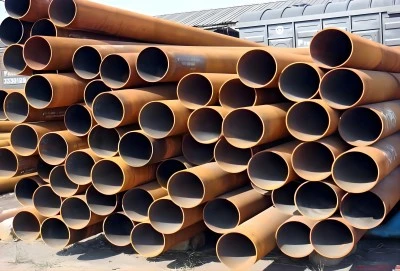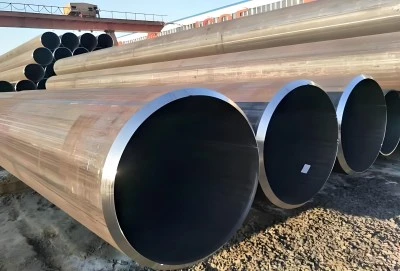The X52 line pipe, as specified by the American Petroleum Institute (API) Specification 5L, is a widely used grade known for its strength and durability.
The pressure rating of an X52 line pipe is dependent on various factors such as its size, wall thickness, operating temperature, and the design standards to which it adheres. In the context of the API 5L X52 specification, while the API 5L standard provides guidelines for the mechanical and chemical properties of the pipe, it does not directly specify pressure ratings.
To determine the pressure rating, engineers typically consider the following factors:
Wall Thickness: Thicker-walled pipes can generally withstand higher pressures compared to thinner-walled pipes of the same diameter. The wall thickness of the X52 line pipe will be specified based on the intended operating conditions and design requirements.
Pipe Size: The diameter of the pipe is another crucial factor in determining its pressure rating. Larger diameter pipes typically have higher pressure ratings than smaller diameter pipes, assuming other factors remain constant.
Operating Temperature: Elevated temperatures can affect the material properties of the pipe, including its strength and toughness, which may influence its pressure rating. It's essential to consider the maximum operating temperature of the pipeline when determining its pressure rating.
Design Standards: The pressure rating of the X52 line pipe may be determined based on applicable design standards such as ASME B31.4 (for liquid pipelines) or ASME B31.8 (for gas pipelines). These standards provide criteria for calculating the pressure rating based on factors like material properties, design factors, and safety margins.
Safety Factors: Engineering codes and standards often incorporate safety factors to ensure the reliability and integrity of pipelines under various operating conditions. These safety factors account for uncertainties in material properties, fabrication, and operational parameters.
|
|
|
X52 Line Pipe Size:
The pressure rating of a line pipe is directly influenced by its size, which includes the nominal pipe size (NPS) and the wall thickness. The NPS is a standardized numerical designation used to identify the approximate outside diameter of the pipe. The wall thickness, on the other hand, refers to the thickness of the pipe's wall material.
X52 line pipes are available in a wide range of NPS sizes, typically ranging from NPS 2 (2 inches or 50.8 mm) to NPS 48 (48 inches or 1,219.2 mm). The wall thickness is often expressed as a schedule number (e.g., SCH 40, SCH 80) or directly in inches or millimeters.
Larger NPS sizes and thicker wall thicknesses generally result in higher pressure ratings, as they provide increased strength and resistance to internal pressures. However, it's important to note that other factors, such as material grade and operating temperature, also play a role in determining the overall pressure rating.
X52 Line Pipe Material Grade:
The material grade of a line pipe is a critical factor that determines its strength and pressure rating. The X52 designation refers to the minimum yield strength requirement of 52,000 psi (358 MPa) for the steel used in the pipe's manufacturing.
X52 line pipes are made from high-strength, low-alloy steel with carefully controlled chemical compositions. The steel contains small amounts of alloying elements, such as manganese, chromium, and molybdenum, which contribute to the desired strength and toughness properties.
The higher yield strength of X52 pipes allows them to withstand greater internal pressures compared to lower-grade line pipes, such as X42 or B. This makes X52 line pipes suitable for applications that require higher operating pressures or more stringent safety requirements.
Temperature of X52 Line Pipe:
The operating temperature of a line pipe can significantly impact its pressure rating. As temperatures increase, the strength and ductility of the steel material can be affected, potentially reducing the pipe's ability to withstand internal pressures.
The API 5L standard specifies temperature derating factors that account for the effect of elevated temperatures on the pressure rating of line pipes. These derating factors are applied to the calculated pressure rating to ensure that the pipe can safely operate within the specified temperature range.
For X52 line pipes, the temperature derating factors are typically provided by the manufacturer or can be calculated based on the API 5L guidelines. It's important to consider the maximum and minimum operating temperatures of the pipeline system when determining the appropriate pressure rating.
API Line Pipe Manufacturers:
LONGMA GROUP not only supplies X52 line pipes but also other grades such as B, X42, X46, X56, X60, X65, X70, and X80. Their product line covers outer diameters ranging from 1/2 inch to 72 inches and thicknesses from SCH 10 to SCH 160.
When selecting X52 line pipes, it's essential to work with reputable manufacturers that adhere to the API 5L standard and implement rigorous quality control measures. Manufacturers like LONGMA GROUP can provide detailed technical specifications, pressure rating calculations, and support to ensure the appropriate selection and application of X52 line pipes.
If you are considering API line pipe manufacturers, LONGMA GROUP is a reputable choice. You can contact them at info@longmagroup.com to discuss your project requirements and explore their product offerings.
To determine the pressure rating of X52 line pipes, manufacturers typically employ sophisticated calculations that consider factors such as pipe dimensions, material properties, operating temperatures, and safety factors. These calculations are based on industry-accepted standards, such as the API 5L and other relevant codes and regulations.
It's important to note that the pressure rating of a line pipe is not a fixed value but rather a range that accounts for various operating conditions and safety margins. Consulting with experienced professionals and adhering to industry best practices can help ensure the safe and efficient operation of X52 line pipes within their specified pressure ratings.














